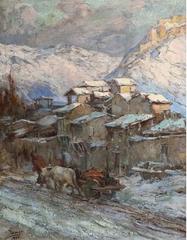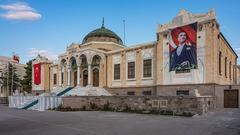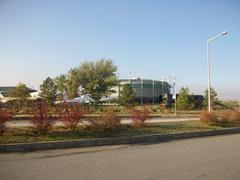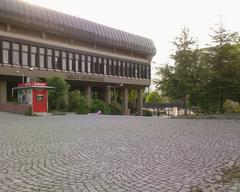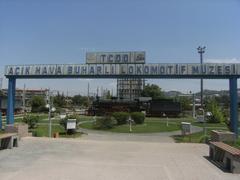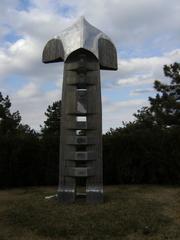Roman Baths of Ankara: Visiting Hours, Tickets, and Historical Sites Guide
Date: 14/06/2025
Introduction
The Roman Baths of Ankara are a remarkable testament to the engineering prowess and urban sophistication of ancient Rome. Situated in the heart of Turkey’s capital, these baths were constructed during the reign of Emperor Caracalla in the early 3rd century CE and served as a vibrant center for hygiene, socialization, and physical activity in the Roman province of Galatia’s capital, Ancyra. Today, the site stands as a well-preserved open-air museum, offering visitors a unique journey through Ankara’s layered past and its enduring connection to classical civilization.
Table of Contents
- History and Construction
- Architectural Layout and Features
- Social and Cultural Role
- Archaeological Discoveries and Preservation
- Urban Context and Nearby Attractions
- Visiting Hours and Tickets
- Accessibility and Travel Tips
- Guided Tours and Visitor Experience
- Frequently Asked Questions (FAQ)
- Conclusion
- References
History and Construction
The Roman Baths of Ankara, locally known as “Ankara Roma Hamamı,” were constructed between 212 and 217 CE during Emperor Caracalla’s reign, a period marked by extensive urban development in the Roman Empire (4traveler.me). Built atop a 2.5-meter-high artificial mound, the baths were strategically located on a main colonnaded road, connecting them to other urban landmarks like the Temple of Augustus and Roma.
The baths were not only built for practical purposes—public hygiene and recreation—but also as a symbol of Ancyra’s integration into Roman society. The site covers approximately 65,000 square meters, making it one of the largest ancient bath complexes in central Anatolia.
Architectural Layout and Features
The Roman Baths of Ankara showcase the quintessential sequence of Roman bathing and social spaces. The complex is divided into two main sections:
The Palaestra (Exercise Yard)
A vast open courtyard where citizens gathered for athletic activities and social interaction before entering the baths.
The Bathhouse
The main bathhouse is organized into the following rooms:
- Apodyterium (Changing Room): Entry area where visitors changed and stored belongings.
- Frigidarium (Cold Room): Spacious cool area with a cold plunge pool.
- Tepidarium (Warm Room): Moderately heated room serving as a transition between cold and hot zones.
- Caldarium (Hot Room): The hottest room, heated by a sophisticated hypocaust system, with hot pools and marble-lined surfaces.
- Laconicum (Sweating Room): Dry heat room similar to a sauna, used for sweating and relaxation.
The baths are notable for their advanced engineering, including a robust hypocaust heating system with brick pillars and flues, marble flooring, and remnants of decorative mosaics (Frommer’s). The use of alternating stone and brick layers helped withstand seismic activity.
Social and Cultural Role
For nearly five centuries, the baths were central to daily life and culture in Ancyra. They functioned as a place not only for bathing, but also for socializing, conducting business, and intellectual exchange. The adjoining palaestra emphasized physical well-being through athletic training, while the baths themselves promoted public health and social integration (Visit Turkey). During the Byzantine period, some areas were repurposed for Christian worship and community events (Tourist Platform).
Archaeological Discoveries and Preservation
Rediscovered during construction work in 1931, the baths have since undergone extensive excavation and restoration. Archaeologists have unearthed coins, amulets, statues of emperors, gravestones, and a variety of artifacts that illuminate the religious, economic, and social life of ancient Ancyra (Turkey Travel Planner).
Between 1997 and 2001, the site was developed as an open-air museum, now displaying approximately 10,000 artifacts, including sarcophagi, sculptures, and inscriptions. Informational signage in multiple languages provides context for visitors, making the museum both educational and accessible.
Urban Context and Nearby Attractions
The baths are located on Çankırı Avenue, about 400 meters from Ulus, Ankara’s historic center. They originally sat along a Corinthian-columned street, highlighting their prominence in the ancient city’s layout. Today, the site is part of a broader constellation of historical sites, including:
- Temple of Augustus and Rome
- Ankara Castle
- Museum of Anatolian Civilizations
- Column of Julian
These sites together map the transformation of Ankara from a Phrygian settlement to a Roman, Byzantine, and Ottoman metropolis (Tripcrafters).
Visiting Hours and Tickets
- Visiting Hours: The Roman Baths of Ankara are generally open daily from 8:30 AM to noon and from 1:00 PM to 5:30 PM, with last entry usually 30 minutes before closing. Hours may vary by season or on public holidays; always check official sources before your visit (Frommer’s).
- Tickets: Admission is affordable (recently reported as 3 Turkish Lira), with discounts for students, seniors, and groups. Tickets can be purchased at the entrance.
- Guided Tours: Available through the museum or local operators, providing deeper historical and architectural insights (Tripcrafters).
Accessibility and Travel Tips
- Getting There: The baths are accessible on foot from Ulus, or by bus and taxi from central Ankara. Parking near the site is limited.
- Accessibility: The terrain includes uneven ancient stones, but paved paths and some ramps exist. Wheelchair users may need assistance.
- Facilities: While on-site amenities are minimal, restrooms and refreshment kiosks are nearby. Visitors should bring water, sun protection, and comfortable shoes, especially in summer.
- Best Time to Visit: Spring and autumn offer mild weather; summer can be hot, so early or late visits are recommended.
Guided Tours and Visitor Experience
Guided tours enhance your understanding of the baths’ history, engineering, and significance. Self-guided visitors benefit from multilingual interpretive panels. The open-air park ambiance allows for free exploration and photography, with opportunities to observe the interplay of ancient and modern Ankara.
Special events and educational programs are occasionally hosted at the site. For updated offerings, consult the Ankara Museums Website.
Image: The ruins of the Roman Baths in Ankara showcasing the remnants of marble flooring and bath chambers.
Frequently Asked Questions (FAQ)
Q: What are the opening hours of the Roman Baths of Ankara?
A: Open daily, typically from 8:30 AM to noon and 1:00 PM to 5:30 PM; verify hours before your visit.
Q: What is the cost of admission?
A: Admission is around 3 Turkish Lira, with discounts for students and seniors.
Q: Is the site accessible for visitors with mobility challenges?
A: Some pathways are paved, but uneven terrain may limit accessibility. Assistance is recommended.
Q: Are guided tours available?
A: Yes, through the museum and local operators.
Q: Can I take photographs?
A: Photography is permitted for personal use.
Q: What other historical sites are nearby?
A: The Temple of Augustus and Rome, Column of Julian, Ankara Castle, and Museum of Anatolian Civilizations are all within walking distance.
Conclusion
The Roman Baths of Ankara stand as a bridge between antiquity and modernity, offering a unique window into the daily life, architectural ingenuity, and cultural richness of ancient Ancyra. With well-preserved ruins, interpretive displays, and proximity to other major historical sites, the baths are a must-see for anyone interested in Ankara’s past. For an optimal experience, check current visiting hours and ticket prices, consider a guided tour, and explore nearby attractions.
To further enhance your visit, download the Audiala app for audio guides and up-to-date information, and follow our channels for more on Ankara’s heritage.
References
- 4traveler.me - Roman Baths Ankara Visiting Hours, Tickets, and Historical Guide
- Tourist Platform - Ancient Structures in Ankara
- Turkey Travel Planner - Roman Baths
- Frommer’s - The Roman Baths
- Tripcrafters - Ankara Tourism and Travel Guide
- Visit Turkey - Exploring the Heart of Ankara
- Official Ankara Museums Website
- Turkish Ministry of Culture and Tourism


